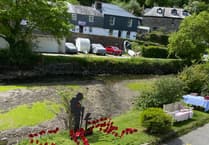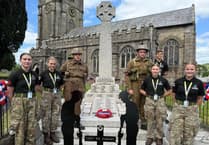THERE are few homes at Menabilly, and there is certainly no shop, but such drawbacks, if they can be called that, pale into significance beside what the area does offer.
This is Rashleigh country, where the famous Cornish family have links stretching back centuries.
John Rashleigh bought the Menabilly estate in 1573, and decided to build a new mansion there. It did suffer damage during the English Civil War, but the family continued to look upon it as their principal home. It is now the residence of Sir Richard and Lady Rashleigh.
Tucked between Fowey and Polkerris Menabilly is also where the sea meets shore at Polridmouth beach (pronounced Pridmouth), where there are two small, attractive, coves.
Of course the name Daphne du Maurier is linked with it as well. While a tenant at the Rashleigh home, during and after the Second World War, she penned such novels as 'The King's General' and 'Rebecca', and was inspired to write her short story 'The Birds'.
The Daphne du Maurier festival, staged in Fowey every May, has led to the creation of a number of walks, based on the du Maurier books - Lynn Goold at the Fowey TIC very much involved in this.
At this time of year a flower festival has often been held at the small church of Tregaminion, this a chapel of ease built at the behest of William Rashleigh.
Its foundation stone was laid by his wife, Rachel, one day in April l8l3. Sadly Rachel died later that year, and the chapel itself was not finished for another two years, the stone she laid serving as a memorial.
Elegant chapel
A history of the chapel, written by John Lydiatt, says that the 'Gentleman's Magazine' announced: 'On l October l8l5 the elegant chapel, built at the sole expense of William Rashleigh, Esq. near his seat at Menabilly, Cornwall, was opened for divine service.' The consecration, by Bishop Pelham of Exeter, occurred in l8l6.
The history explains that 'for many years the little chapel gently decayed, the wood became worm eaten, the bell unfit to be used, the whitewash flaked off the walls.'
However, it has since been renovated with a new roof and the windows re-done.
The small committee which has overseen this, and has been involved in the fund-raising, has also carried out extra work themselves, and seen to other improvements, such as re-carpeting.
Former glories
One of the committee members is Doris Robins, whose mother Elsie is over l00 and regards Tregaminion as her church.
Her sister, Mrs Roberts, always wished to see it returned to former glories but unfortunately died before that happened. Elsie, however, has seen its restoration.
Doris said she joined the committee around eight to nine years ago, and a weekly service is held there. This is usually an Evensong at 3pm, although on the third Sunday in the month there is usually a Communion at 8.30am. Doris said she believes it was always open to members of the public, being attended by estate workers.
The chapel comes under the auspices of Tywardreath church, where the current incumbent is Rev Chris Malkinson.
The committee is currently led by Richard Meade-King, who said the original group, formed 25 to 30 years ago to raise money for restoration purposes, comprised his wife Hilary, Veronica Rashleigh, and the late Mrs Morwenna Coombe who was the sister of the late Philip Rashleigh. They got together after the diocesan architect condemned the chapel roof and said it was unsafe even to put people on it to carry out repairs. Their fund-raising, and applications for grants, eventually meant two phases of renovation took place at a total cost of around £75,000.
Help
During these works a new drainage system was installed, with a drainage sump placed in a field as a soakaway.
Phase one was completed in l993, and the second phase around two years ago, with a ceremony held to mark the occasion.
Help came from a number of directions, but especially from the Cornwall Historic Churches Trust who gave a grant, and outlined ways in which fund-raising, and grant applications, could be best undertaken - and who was best to contact, such as county and district councils.
With help from many people beyond those living in the small number of houses - about 22 - on the headland, fund-raising events took in coffee mornings, parties and evening lectures held at Trenython.
Mr Mead-King, who became committee chairman after he retired, about 14 years ago, said he was just saddened the late Canon Oatey, who had given tremendous backing, had not lived long enough to attend the ceremony to mark the end of the works. He said: 'I know he would have loved to have been there at the kill!'
Apart from the successful flower festivals Tregaminion has also hosted an exhibition of work by local artists, and an embroidery exhibition at which antique as well as modern day embroidery was on display - the exhibits including a cap embroidered for Queen Elizabeth l.
Bob Acton, in his 'Around the River Fowey' walks explains that the cottage on the beach at Pridmouth, resplendent with lawns and pool, stands where the watermill serving the Menabilly estate used to be.
There was once, as well, a grotto here, an octagonal building erected in the late l700s by the Rashleighs and decorated with a range of shells, fossils and minerals. Sadly this has not withstood the march of time.
Ideal holiday
Those seeking an ideal holiday in the heart of Cornwall, at the heart of a working farm, are extremely well served by both Tregaminion Farm and Menabilly Barton farm, which both offer excellent accommodation. Tregaminion Farm has been run by Jeremy and Jill Rowe for around four years. A beef and arable farm it offers a home from home for visitors, most usually families, who enjoy holidaying there so much they more often than not book again the following year.
Youngsters are able to enjoy seeing a host of animals, apart from the cattle, such as rabbits, guinea fowl, and friendly goats, calves and ponies - most the pets of Jill and Jeremy's two daughters, Libby aged two and Katie aged four. Good, traditional, food is offered, and Jill said she happily caters for all tastes, whether for vegetarians or those with special diets and needs.
It is also a haven for walkers, as the farm is on the Saints Way. Ramblers frequently also choose to stay at Menabilly Barton farm, set on the footpath down to Pridmouth beach.
Beef farmer Richard Dunn has lived there all his life, and his wife, Sarah, for 26 years, and have brought up their son and daughter there. They also offer a warm welcome, Sarah saying that in the past years quite a few people from abroad, especially Germany, have chosen to stay there for a holiday.
Visitors
She said the Daphne du Maurier link attracts many visitors, but so do Rosamund Pilcher books, and now the Eden Project.
Once again, visitors are able to benefit from living on a working farm during their holiday, complete with the horses that Sarah and Richard's daughter, Jess, loves to ride.
Nancy Higgs lives in the small hamlet near the car park, where those wishing to walk to Pridmouth leave their cars, and then pay a very reasonable car park fee in the milk churn at Menabilly Barton.
Nancy has been in Menabilly for about two decades, and said her favourite time of year is the summer when she can sit out in her garden, and take in the sun and the lovely views.
It was from a local beach that a daring escape took place during the Civil War. The Roundheads had surrendered during a skirmish at Castle Dore, near Fowey - and a large number of their troops were hemmed in by Royalists in the narrow neck of land between the River Fowey and Tywardreath Bay. Under the cover of night, however, they managed to board a number of boats and slip away to freedom from the cove.
There have been a few shipwrecks around the coast. Nearby walkers can see the remains of the Belgian coaster, the Romanie, which went down over 70 years ago.
One dominant feature of the Menabilly coastline is Gribben Head, where a daymark was erected on the behest of Trinity House, as a guide for ships using St Austell Bay.
handsome
On the wishes of William Rashleigh it was a handsome, rather than intrusive, feature.
Bob Acton describes how one of the beacons, used during the Armada, was placed on the Gribben (meaning little ridge or crest of a bird), and one of the signal stations, built as a defence against an invasion by Napoleon's navy, was also sited there, the ruins of which are still visible.



